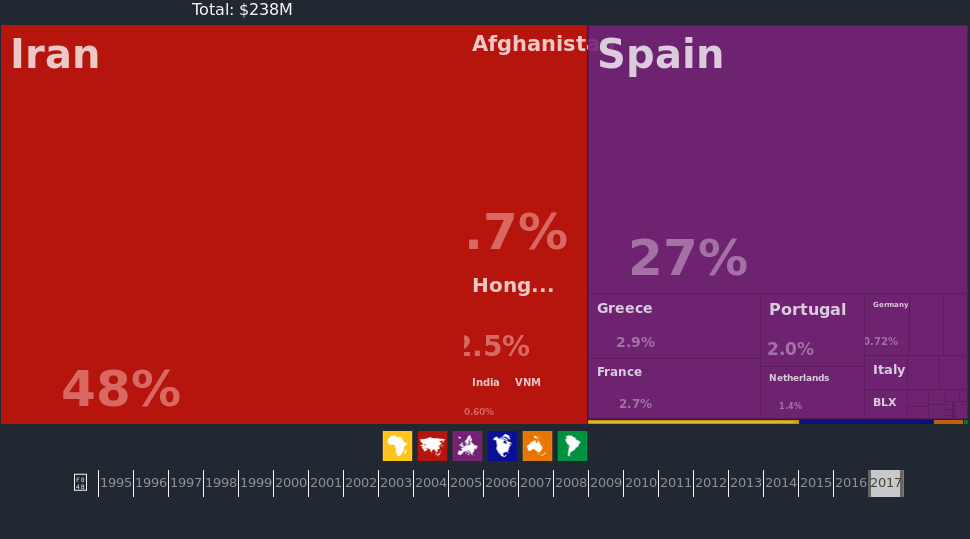Saffron is one of the most expensive and valuable spices in the world. In addition to using as a seasoning in food, it is used extensively in pharmaceutical industry. This product (saffron) has one of the most widespread trade markets around the world in a way that saffron trade is one of the most economical and profitable world trades for saffron exporters.
In addition to the countries that have cultivated saffron from the past, today, many countries in different parts of the world grow saffron in order to enter the global market as a saffron exporter and achieve a profitable trade. Meanwhile, Iran is known as the top saffron producer in the world.
Effective Factors on Saffron Quality
Saffron is best grown with high quality in cold regions. This is considered one of the main factors in distinguishing between high-grade and low-grade saffron. The colder the region, the higher the quality of saffron will be.
Saffron can grow in cold regions and is highly resistant to cold weather; saffron corm can grow in up to minus 40 degrees Celsius. It is also suitable for dry and semi-arid lands since it requires less water compared to other agricultural products. Iran, as the largest saffron producer and exporter, has the most compatible climate required for saffron cultivation.
High quality saffron can be marketed if it is stored with care after harvest which is another important factor in the process of producing and preparing saffron.
Iran’s saffron is among the highest quality saffron in the world since it has been stored with considerable care after harvest from the past in addition to the suitable climate and rich soil.
Saffron should be stored in a glass container away from sunlight and humidity after being yielded and dried. If the necessary points are not observed, it will lose its essence and taste. Therefore, it will be low-quality and low-grade.
It should be noted that dried high-quality saffron is not aromatic so much. However, when it is soaked in water, it emits a strong scent and tastes great. Saffron exporting countries can preserve the quality of saffron by observing the principles of preparing and storing it. Thus, they will be known as high-grade saffron producers and exporters in the world.
Global Saffron Production Volume
Iran has produced and exported about 105 tons of saffron in 2018. This amount has increased 40 percent in comparison with previous years. Currently, Iran is the first and largest saffron producer in the world.
You may want to know > Everything about customs duties for saffron exportation
Iran’s share is 44 percent among all saffron producers around the world in the world market. 105 tons of saffron is the amount that is exported by Iran and does not include local saffron use in Iran. Therefore, the produced amount of saffron in the country is much more than the statistics above.
It is also noteworthy that Iran, as the first saffron producer, has not used all of the capacity of agricultural lands for cultivating saffron. This is because unfortunately saffron production has not been organized in Iran yet. Therefore, Iran can increase its revenue in the world market through producing its high-quality saffron by proper planning and supporting farmers.
Saffron Producing Countries Ranking
Iran and Spain are the countries that have a history of producing and using saffron in their culture from the past and are among the first and oldest saffron exporters in the world. Saffron producing countries including both of these countries are discussed in the following.
Rank One: Iran’s Saffron
According to the deputy of the Ministry of Agriculture Jihad, Iran’s share of saffron production in the world is about 95-92 percent. However, a large amount of produce is not recorded globally, for example local use which is not recorded in global statistics. The anticipated amount of saffron export for Iran is about 500 tons in 2020.
This figure demonstrates Iran’s export in 2017.

The evidence shows that the statistics are declining. Iran’s share was 36.7 percent in saffron global market in 2018 and was valued about 101.32 million dollars. This indicates that it has declined by 10% in comparison with the previous year. Iran’s saffron export in 2018 is shown in the following figure.

About 24 provinces in Iran produce saffron since 2018 and nearly 124 thousand hectares of the lands are under saffron cultivation.
Birjand, Qaen, and Ferdows in South Khorasan Province, Gonabad and Torbat-e Heydarieh in Razavi Khorasan Province, North Khorasan, Isfahan, Kerman, Fars, and Yazd provinces have the suitable conditions for cultivation and produce high-quality saffron.
Southern and western cities in Iran have turned to saffron cultivation in recent years and have been able to produce high-quality saffron using new agricultural methods, greenhouse cultivation, and improved corms.
Which Countries is Iran’s Saffron Exported To?
Spain buys 50% of Iran’s saffron
Iran, as the largest producer and exporter of saffron, produces 587 million dollars saffron annually about 50 percent of which is sold to Spain. Similar to Iran’s saffron, Spain’s saffron is high-quality. However, Spain’s saffron production volume is not significant compared to the amount that it imports.
Hong Kong 16%
After Spain, Hong Kong is at the second rank with importing 96 million dollars.
United Arab Emirates 15%
UAE is at the third rank importing 89 million dollars of Iran’s saffron.
Other Countries 19%
Iran has exported about 400 tons of saffron to 60 countries in 2017. Other countries after Spain, Hong Kong and UAE include Afghanistan, China, Italy, Qatar, Germany, France, Kuwait, Georgia, Taiwan, Netherlands, Bahrain, Oman, Australia, Japan, England, morocco, Switzerland, Belgium, Canada, Singapore, India, Hungary, turkey, Malaysia, Iraq, Pakistan, South Africa, Poland, Philippines, Greece, and Austria.
| Rank | Country | Weight | Value in Rials | Value in Dollars |
| 1 | Spain | 235,903.00 | 11,311,227,362,999 | 325,649,983 |
| 2 | Hong Kong | 63,909.00 | 3,359,962,393,790 | 96,478,726 |
| 3 | UAE | 61,668.00 | 3,091,822,941,671 | 89,471,139 |
| 4 | Afghanistan | 14,551.00 | 789,119,337,089 | 22,748,350 |
| 5 | China | 7,810.00 | 410,845,110,449 | 12,128,760 |
Rank Two: Spain’s Saffron
Spain is the second largest saffron producer in global ranking after Iran. Universities in Spain carry out extensive research on saffron and inform the farmers of the best conditions for saffron cultivation. The climate of regions that cultivate saffron in Spain is similar to the climate of regions that cultivate saffron in Iran such as Qaen County. Spain produces 25 tons of saffron yearly. Nevertheless, it is one of the main saffron exporters in the world.
Spain has 20.7 percent of saffron export market valued 57.08 million dollars. United States of America, Saudi Arabia, and Italy are the three top export destinations for Spain’s saffron.
Rank Three: Afghanistan’s Saffron
According to the latest reports, Afghanistan has harvested 18 tons of saffron from the 6200 hectares under cultivation in 2018. Saffron export valued 58 million dollars is a thriving market for this country. Afghanistan exports a considerable amount of its saffron to India, Saudi Arabia, France, UAE, USA, and Turkey.
Afghanistan imports about 65.7% of its saffron from Iran. Iran’s saffron still comes first in all countries. Afghanistan’s saffron has a lot of customers and its quality is close to Iran’s because of the similarities in climate.
Rank Four: India’s Saffron
More than 20 thousand families cultivate saffron and earn their income in Kashmir, India. About 200 villages in five regions of Kashmir produce saffron. India imports 31.06 million dollars of saffron which comprises 11 percent of world’s saffron import. India’s saffron is mainly exported to Hong Kong.
Rank Five: Greece’s Saffron
The lands in northern regions of Greece are under saffron cultivation. Overall, Greece has 1000 to 1200 hectares of land under cultivation. The total saffron harvested from these lands is about 8 tons annually. Greece exports 9.47 million dollars of saffron.
Although Spain is the main saffron exporter in Europe, Greece has been able to place itself among the main saffron producers in the continent. Greece exports saffron to France, Poland, Spain, Italy, Switzerland, and Germany.
Rank Six: Italy’s Saffron
Italy has the next rank in producing saffron. It produces about 600 kilograms of saffron annually. Most of Italy’s produce is to meet local use. Italy has invested on the lands in Morocco and is one of the largest importers of Morocco’s saffron.
Rank Seven: Morocco’s Saffron
Morocco’s government has become one of the top supporters of saffron production recently after Afghanistan. Morocco could be considered one of the top saffron producers. It has mainly put its mountainous regions under saffron cultivation. Morocco has about 600 hectares of land under cultivation and 500 families work on these farms. Morocco’s saffron is also high-quality.
Rank Eight: China’s Saffron
China has entered the global market as a saffron producer in recent years. Saffron is imported to China from Hong Kong, Germany, Afghanistan, and Portugal and exported to countries such as Saudi Arabia, Italy, England, and Hong Kong after packaging and branding. Currently, China has reached the top of the list of saffron producers and exporters by investing on greenhouse saffron cultivation.
Conclusion
As mentioned above, a lot of countries are trying to gain a share in saffron global market and introduce themselves as saffron exporters. As a result, the competition in this profitable trade is getting more difficult day by day. Therefore, Iran has to take some action in order to secure its position. One of the important factors is preserving the quality of saffron in the process of transfer. Saffron packaging is a key factor in this regard. It also plays an important role in value added in addition to preserving the quality of saffron. Furthermore, it can help recognize Iran in global market and among saffron customers more than before.
This post is also available in: العربية (Arabic)


